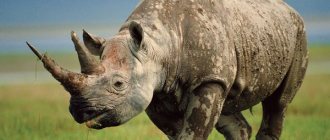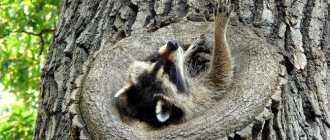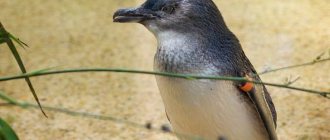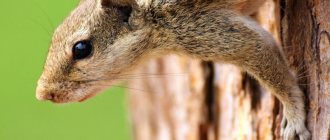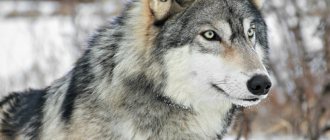How unusual the appearance of different species of monkeys can be! Attention will certainly be attracted by either the huge nose, or the downright human eyes and thoughtful gaze, not to mention the behavior of these mammals, which noticeably distinguishes them from many other representatives of the class. It is known that primates have significant similarities with humans and are distinguished by unique intelligence.
By the way, many decades of research have shown that a person’s closest relatives can easily communicate using sign language and even pass simple memory tests.
Here is a selection of species of monkeys with unusual appearance, the existence of which not everyone knows.
Bankan tarsier
The peculiarity of this charming baby is her huge eyes with brownish irises, which can reach up to 16 millimeters in diameter. And this despite the fact that the average body length of the animal is only 12-15 centimeters. If such proportions were transferred to a person, the size of his eyes would be equal to the size of an average apple.
Another distinctive feature of the miniature animal is its long tail, which acts as a balancer and even steering when moving. The tarsier, who prefers vertical movement, can even use it as a support during a static position.
Despite its charm, the animal did not receive favorable treatment from the inhabitants of its native Southeast Asia. Here, according to various legends, he represents an evil gnome, an enchanted creature, and even a pet of forest spirits. And a meeting with a harmless baby is considered dangerous mainly because of the eyes glowing in the dark. But, fortunately for the tarsier, harming it is also a bad omen, foreshadowing misfortune.
Origin
Some argue that chimpanzees should be placed in the same genus as humans, Homo, based on the fact that chimpanzees and humans diverged only 4–6 million years ago . The consequences of changing taxonomic classification could have a huge impact on the perception of chimpanzees and the rights extended to them. For example, categorizing chimpanzees as "Homo" may make it unethical to keep them in zoos or use them in research.
Photo: Pinterest
Every few years or months, we are surprised to hear about the differences and similarities between the chromosomes and DNA design of humans and primates. Over the past decade, studies have shown similarities of 98.8%, 95%, 96%, 86-89%, and a recent study by Jeffrey P. Tomkins (Institute for Creation Research, Texas, USA) suggests it is as low as 70%.
As more innovative research methods emerge, further reports and numbers may become more accurate. Today, scientists have not yet come to a consensus to what extent the DNA of chimpanzees and humans may be similar.
Crybaby
The monkey got its name due to the extended sounds it makes, reminiscent of a child's cry.
This mammal is considered vulnerable and has been listed on the International Red Book. The rapid decline in the species' population is caused by deforestation and poaching in its habitat - South America.
Favi or brown capuchin
Miniature favies barely reach 36 centimeters in height, while the length of the tail is twice the size of the body. A distinctive feature of the monkey is a patch of black hair on the top of its head, which is called a cap, but perhaps the main feature is the ability to curl its tail into a ring. By the way, this is the only species of capuchin that has this ability.
These animals have gained fame as one of the most intelligent species of primates. This is proven, for example, by the fact that in nature they often use stones to open the nut, and wipe off the mucus from captured frogs using tree bark.
Capuchins are often kept in captivity and at home. Moreover, they are sometimes trained to work with paralyzed people or act as guides for the blind.
Interspecies relationships
It was long thought that chimpanzees had no natural predators due to their large body size, but field studies have shown that leopard attacks often cause death for the primate. However, it is unclear whether leopards prefer to hunt chimpanzees or perhaps it is just a matter of chance. Lions are also capable of killing chimpanzees, and their predation is often observed in Tanzania.
White-breasted Capuchin
The cute monkey owes its name to the white spot on its chest that extends to its shoulders. And its brown color on the back and head resembles a robe with a hood, which, by the way, rarely covers the animal’s forehead. The level of rise of the black fur depends on the sex and age of the individual. Usually the “hood” is raised higher in adult capuchins, but females lift it up when they are still young.
Recently, the animal has become popular in home breeding. However, it should be remembered that the animal is extremely active and needs the company of its own kind, and the place of detention must provide the exotic pet with free movement. Interestingly, a smart capuchin is able to imitate its owner and easily learn some simple skills.
Did you know?
- "Chimpanzee" translates to "human-like." Europeans began to use a similar term in 1738.
- The first chimpanzee arrived on the European continent in 1641.
- The average lifespan of chimpanzees is 40 to 45 years, although in captive individuals it can reach 60 years.
- Chimpanzees are territorial and very aggressive animals that often kill their relatives.
- In captivity, chimpanzees sleep about 9 hours a day.
- Chimpanzees Enos and Ham are astronauts who completed suborbital and orbital flights as part of the Mercury space program.
Saki monk
Covered with long shaggy hair and a bushy tail, this primate gives the impression of being sad and pensive. Like the previous participants in the selection, it is distinguished by its small dimensions: its height barely reaches 50 centimeters, and the length of its tail is approximately commensurate with its body, and the weight of the sad animal is approximately 2.5 kilograms.
The monkey got its name from its hair-covered shoulders and head, which gave rise to an association with a monk's hood. Representatives of this species are quite silent and rarely make sounds, although they can boast of a loud and shrill voice.
Fortunately, the population of the pretty creature is quite large and is not endangered.
Geographical range
Chimpanzees live in Equatorial Africa. Their range covers 22 countries : Angola, Burkina Faso, Burundi, Cameroon, Central African Republic, Congo, Cote d'Ivoire, Democratic Republic of Congo, Equatorial Guinea, Gabon, Ghana, Guinea, Guinea-Bissau, Liberia, Mali, Nigeria, Rwanda, Senegal, Sierra Leone, Sudan, Tanzania and Uganda.
This puts the total area of chimpanzee range at about 2.5 million km² , although the majority (about 77%) of the total estimated population size resides in only two countries, Gabon and Congo.
Odzala National Park in Congo boasts the highest chimpanzee population density in Central Africa, with 2.2 individuals per square kilometer.
Common marmoset or wistity
This fragile little thing is the size of a squirrel. Its fur is long and very soft, and in adult individuals, touching tassels are formed on the ears, which have become a distinctive feature of the marmoset. Another feature of the monkey is its long claws on its toes, which allow it to deftly cling to branches.
These kids are very emotional, their feelings are expressed through facial expressions, various intonations of the voice and even the movement of the hair on their heads. The monkey is easily excitable and often panics. The marmoset's activity begins to decline 30 minutes before sunset; during this period, it returns to its roosting area, where it falls asleep, covering its head with its tail.
The monkey's funny behavior has made him a favorite in home corners. Having adapted to a human home, the soft little lump will definitely delight its owners with its funny tricks and tricks.
Communication
Chimpanzees communicate with each other in the same way as humans, non-verbally, vocalizing, gesturing and using facial expressions. During communication, the area of the brain that is responsible for speech in the human brain is activated.
Photo: Anup Shah
Vocal communication conveys a wide range of emotional states and intentions and often influences the behavior of those individuals that hear the sounds. One important sound is the "hoot", which is most often made by adults to express pleasure from eating or excitement. Loud calls, similar to a dog's bark, are used to attract the attention of other community members to a possible danger or food source, as well as to locate other groups in the area.
Pygmy marmoset
This monkey is considered one of the smallest primates on Earth. In size it is slightly larger than a mouse and can easily fit into a tablespoon. Its entire body, including its muzzle, is covered with brown fur that has a greenish tint, and the tip of each hair has a yellow transition. The monkey's tiny ears are bare, but securely hidden under thick fur.
Despite her harmless appearance, the baby will still be able to fight back the offender by using her long and very sharp claws.
Communication between marmosets is based on a kind of chirping. However, it is unlikely to be able to eavesdrop on their “conversation”, since the high-pitched sounds they make are inaccessible to human hearing.
Nowadays, marmosets, along with other miniature relatives, are caught in large numbers for sale in pet stores. This is what led to a reduction in their population in nature. Let us note that this species has been endangered before – the animal has long been considered a carrier of yellow fever and malaria.
Eating habits
Chimpanzees' diet consists mainly of fruit, but they also eat leaves and leaf buds, and the rest of their daily menu consists of a mixture of seeds, flowers, stems, bark and tree exudates.
Chimpanzees are highly specialized frugivores . They supplement their largely vegetarian diet with insects, birds, birds' eggs, honey, soil, and small to medium-sized mammals (including other primates). Their most common prey among mammals are:
- red colobus monkeys (a type of monkey);
- blue duikers;
- bushbuck (a type of antelope);
- red-tailed monkeys;
- baboons;
- warthogs.
Photo: Natural History Museum
Chimpanzees spend on average half of their day feeding and spend a lot of time moving from one food source to another. However, the actual time spent feeding correlates with the amount of processing time of the food consumed.
The use of tools to obtain certain foods has been documented in all chimpanzee populations. Sticks, stones, grass and leaves are all materials converted into tools by primates and used to collect and consume honey, termites, ants, nuts and water. While these tools may seem too primitive to be considered true tools, there is certainly evidence that they require intelligence and skill to create and use, and their lack of sophistication should not detract from the fact that they are tools after all.
For example, to extract honey from stingless bee hives, chimpanzees use short sticks stripped of leaves, twigs, and bark to most efficiently scoop honey from the hive. On the other hand, to extract honey from the hives of aggressive African bees, chimpanzees use much longer and thinner sticks to avoid the painful stings of these stinging insects. Similarly, chimpanzees remove leaves from long, thin sticks and use them to remove ants and termites from their ground nests.
Using a "hammer and anvil" made from fallen branches, rocks or tree roots, chimpanzees crack hard nuts.
Often these items are not found together or near the source of the nuts, so chimpanzees must be resourceful to assemble the appropriate equipment to consume this important high-protein, high-fat food.
Chimpanzees also use the leaves as sponges or spoons for drinking water. Having chosen a certain type of leaf, the primate crushes it in his mouth and then puts it in water; the crushed leaves act like a sponge, then the chimpanzee sucks the water out of it and repeats the process. This behavior is especially common where water is scarce at certain times of the year and is so deep that chimpanzees cannot easily access it directly with their mouths.
Tamarins
Regardless of the subspecies, these monkeys are sure to be remembered for their unusual and elegant appearance. They are wrapped in thick and soft wool, and their color palette is more than diverse. A characteristic feature of individuals of this species was precisely the combination of all kinds of shades in the most extraordinary variations. One cannot but agree that the appearance of representatives of this genus may well make one believe in their fairy-tale origins.
Scientists count over ten species of tamarins, some of them are presented below.
Enemies of monkeys in the wild
There are many animals that will not refuse to feast on primates. Leopards are considered the most dangerous enemies. They try to keep the primates lower than them in the trees so that they cannot reach the brittle tops.
At such a height, it is not difficult for a predator to catch the chosen prey. Primate enemies also include lions, cheetahs and tigers.
Brown-headed tamarin
The brown-headed tamarin is the smallest representative of its genus, its height reaches only a few tens of centimeters, and its weight does not exceed half a kilogram. The “calling card” of this monkey is its fluffy white eyebrows; another characteristic feature is the long hair that frames its muzzle and creates a mane.
Dimensions
The order of primates contains a wide variety of species, differing significantly in size and body weight.
| Type name | Body length, cm | Weight, kg |
| Gorilla | 175 | 150 |
| Orangutan | 150 | 100 |
| baboon anubis | 75 | 25 |
| Drill | 70 | 20 |
| Gulman | 60 | 11 |
| Piebald tamarin | 28 | 0,420 |
| Wistity | 18 | 0,25 |
Crested tamarin
This elegant monkey owes its name to the funny white crest that adorns its small forehead and the back of its head. However, the animal’s “hairstyle” also serves as an indicator of the mood of its owner: by its position it is easy to determine in what frame of mind the animal is. For example, when worried, the tamarin will raise its crest, and sometimes, to demonstrate its ferocity, the tamarin may bare its sharp teeth.
Piebald tamarin
This subspecies received its name due to its black face, uncovered by hair and contrasting with the various colors of the fur. Most often it can be brown, black or silver.
The animal chooses secondary forests, swampy areas or forest edges as its permanent habitat, and devotes most of its time to climbing trees. It is quite rare to see an animal low, since it is mainly located at an altitude of 10 to 12 meters. Unfortunately, the destruction of the pinto tamarin's habitat and interspecific competition pose a threat to its long-term survival.
Natural habitat
Photo: Westend61
Due to their wide geographic distribution, chimpanzees inhabit a wide variety of habitats, including tropical and montane evergreen forests, wetlands, and dry savannas.
To live in such different types of habitats, chimpanzees must be quite adaptive . In low altitude tropical forests, temperatures vary little from season to season, humidity is always high, and there are several dry days a year. In contrast, dry areas, including the northern and southeastern limits of their range (Senegal and Tanzania, respectively), exhibit enormous fluctuations in temperature and humidity throughout the year, as well as long dry periods. Another dry habitat where chimpanzees have been studied is Uganda, where the average annual rainfall is 1206 mm and maximum temperatures reach 34 °C.
Hussar
This representative of the monkey family differs from the previous participants in the selection in its size. Its weight can reach 12 kilograms, and the body and head are equal to the length of the tail and amount to 60-75 centimeters. At the same time, the animal can boast of its graceful physique and long, slender limbs. In addition, it is capable of reaching speeds of up to 55 kilometers per hour, and in an alarming state it takes a static position on two legs, leaning on its tail. When experiencing fear, the animal shows appropriate emotions, jumping from place to place.
A distinctive feature of the species is its well-developed cheek pouches, in which the monkey can carry food.
Types of monkeys with photos and names
The infraorder of monkeys includes two parvoorders:
- Broad-nosed monkeys (Platyrrhini).
- Narrow-nosed monkeys (Catarrhini).
Currently, more than four hundred species of monkeys are known. At the same time, there are the most famous and unusual ones, such as:
Black howler monkey (Alouatta caraya)
Representing the "Arachnid" monkey family. The natural habitats of this species are Paraguay, Bolivia, Brazil and Argentina. A feature of the species is their ability to create quite loud sounds, in the form of a roar. The coat color of males is mostly black, but females have a yellow-brown or olive coat. Adults grow in length up to 70 centimeters maximum, with a weight of about 7 kg, no more, while females are somewhat smaller, both in weight and in size. The basis of the diet of these animals is foliage and fruits.
Mourning capuchin (Cebus olivaceus)
It belongs to the family of “Tail-tailed” monkeys and lives in the untouched forests of Venezuela, Brazil and Suriname. Males gain weight within 3 kilograms, and females weigh no more than 2 kilograms. The fur of these animals is colored brown or light brown, with inclusions of a grayish tint. In the head area you can see a triangle formed by black hairs. Animals of this species are prone to infacticide, when their young are deliberately killed. Individuals protect themselves from blood-sucking insects by rubbing their fur with poisonous centipedes. The species feeds on almost everything that gets in their way.
Blue monkey (Cercopithecus mitis)
Found in woodlands or bamboo plantations on the African continent. The monkey's fur is gray with a blue tint, and there is a white stripe above the eyebrows, which looks like a crown. Adults reach a length of about 70 cm and weigh no more than six and a half kilograms. Males have clearly visible white whiskers, as well as relatively long fangs.
White-handed gibbon (Hylobates lar)
It represents the family of the same name and prefers to live in the forest tropics of China and the Malay Archipelago. Adults are slightly more than 60 cm long and weigh no more than 6 kilograms. The main coat color is black or brown, but the arms and legs are always white. The family feeds on leaves, fruits and various insects.
Eastern gorilla (Gorilla beringei)
It is considered one of the largest monkeys found on the planet. The height of individuals reaches 1 meter 90 centimeters and weighs more than 150 kilograms. This massive animal has a large head, broad shoulders, an open chest and long legs. The main coat color is black, but some subspecies of gorillas are characterized by the presence of a bluish tint. On the back of adult males you can see a strip of silver-tinged fur. The diet includes mushrooms, plants and fruits, as well as invertebrates.
Pale saki (Pithecia pithecia)
Represents broad-nosed monkeys. Saki is distinguished by long and shaggy hair, while adult individuals do not grow more than 50 cm in length and weigh no more than 2 kilograms. The main part of the body coat is black, while the face is pink or pure white. Females have lighter shades, leaning more towards grey, but they also have a distinct complexion, with lighter shades. They feed mainly on fruits and seeds of plants, and their habitat is confined to Venezuela, Brazil and Suriname.
Hamadryas (Papio hamadryas)
Represents the species of narrow-nosed monkeys and the genus “Baboons”. The habitat extends to the Asian and African continents. They grow in length to almost 1 meter and weigh about 30 kilograms. Males have a unique coat distribution, which is reflected by the presence of elongated hair on the shoulders, as well as on the chest. Females are characterized by a darker coat color.
Japanese macaque (Macaca fuscata)
The name itself indicates where this animal prefers to live. The macaque's natural habitat is associated with the northern part of the island of Honshu, although not many individuals have been introduced to Texas. Adult males grow up to a meter in length and can weigh no more than 15 kilograms. These primates have bright red skin, which can be seen in the muzzle area, as well as on the buttocks, since these areas do not have hair. The rest of the body is covered with thick fur of a dark gray shade, with inclusions of a light brown color.
Common chimpanzee (Pan troglodytes)
It is a species of monkey that lives in forests with a tropical climate, as well as in Africa, within the humid savannah. The species is distinguished by the fact that its body is covered with coarse and stiff fur of a dark brown color. Within the mouth and tip, the coat is almost white, and the feet, muzzle and palms are hairless. Although the common chimpanzee is an omnivore, the basis of its diet consists of plant foods.
Pygmy marmosets are of particular interest because they are the smallest monkeys on the planet. Their natural habitats extend to the forests of South America.
Green monkey
The small primate got its name because of its peculiar green “cap”. The body of such a monkey is covered with short gray-yellow hair, and white mustaches scatter on its muzzle. The animal's face is black, while the skin of the palms is yellowish. The monkey also has cheek pouches, like those of hamsters, in which it stores food reserves.
The outwardly harmless animal has sharp fangs, which it can easily use against a potential enemy.
It is interesting that if the monkey is in its normal state, the tip of its tail will be lowered; when experiencing fear, it will raise it parallel to the ground, and will demonstrate trust in the “interlocutor” with its tail up. The sounds that the animal makes in different situations are also varied. For example, males can end a conflict with a rude cry, and purring will accompany the playful struggle of young individuals.
Often the green monkey can be found performing hygiene procedures. The animal spends several hours a day on self-care, which consists of examining the fur for the presence of insects, parasites and dirt.
Reproduction and offspring
As a rule, almost all species of monkeys exhibit well-defined sexual dimorphism, which is represented by brighter body color and larger sizes of male individuals. And, nevertheless, in different species the manifestation of sexual dimorphism is of a different nature. Differences between females and males are most pronounced in polygynous species, where strict male dominance is evident. These types of monkeys include proboscis monkeys and baboons.
For monkeys that form herds, sexual dimorphism is less pronounced if the males in the herd are not overly aggressive. These monkeys include gorillas and macaques. Species that live in pairs have the same minor differences, when the female and male take part in caring for their offspring. These are monkeys such as marmosets, marmosets and tamarins.
Interesting to know! In monkeys, compared to other species of mammals, the entire troop is involved in raising the young. In marmoset monkeys, most of the care for the growing offspring falls on the shoulders of the male.
Howler monkeys and capuchins unite in flocks with a clear hierarchical structure, and the gestation period, regardless of the species, does not differ significantly. Marmosets have a gestation period of about 145 days, while baboons have a gestation period of about 175 days. Almost all species of monkeys give birth to one baby. But there are exceptions here, since marmosets and tamarins quite often give birth to twins. As a rule, at first the offspring clings to the mother's fur and feeds, being in constant motion.
Cynomolgus macaque
This Red Book animal has beautiful gray eyes and thick fur with a grassy look.
The Javanese macaque is also known as a crabeater, which is due to its gastronomic preferences. Having tracked down a crab from an “ambush”, the primate quietly creeps up to it and breaks its shell with a stone, after which it feasts on its meat.
Another interesting feature of the macaque is its behavior in a group. Zoologists noticed that males, trying to take a leadership position in the group, helped their relatives get food, thereby gaining the authority of the members of the pack. In addition, his sociability and cheerful disposition have already provided the monkey with an honorable place in the home zoo corner.
